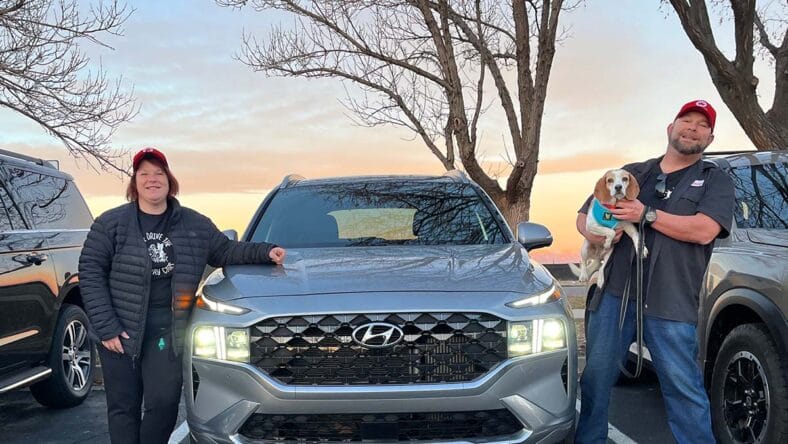Animal Rescue Transportation Unites Two of My Favorite Things: Driving and Dog Rescue
Animal rescue transportation takes a bit of care and planning; the right car is helpful too. Here's what I've learned, and used, for a recent Operation Frodo 1650 rescue drive.

Delivering Rescue Animals to Foster and Forever Families is a Mission – and a Passion
I recently spent four days driving a 2023 Hyundai Santa Fe about 1,600 miles as part of a dog rescue mission.
The event’s name — Operation Frodo 1650 — was inspired by a dog (named Frodo) that was saved and adopted last year by auto journalist and TV personality Nik Miles. He arranged a second transport event from Omaha to Portland – a 1,650 mile trek. When the event was scheduled for this year, I wanted to take part. I participate in other animal rescue events; it’s very close to my heart.
Related: Love to Road Trip? How a Dog Seat Belt for Pet Travel Can Help Fido Love The Ride

A Girls Guide to Cars authors Teia Collier and Tanya Gazdik on the road with Operation Frodo 1650. Photo: Tanya Gazdik
Does Animal Rescue Really Require Transportation?
So why drive a bunch of rescue dogs across the country? Aren’t there rescues and adoptions happening in every major city? If that thought crossed your mind, you aren’t alone.
I’ve done cross-border transports from the U.S. (Detroit) to Canada (Windsor) for many years. They involve dogs coming from high-kill shelters in Ohio and Kentucky and are driven to the foster homes of rescues in Ontario. Transports of rescued animals happen nationwide year-round.
Transports are (mostly) supported by groups including the ASPCA, the Humane Society of the United States and Maddie’s Fund (links at each of the organization’s names explain their stance on transporting rescue dogs). There’s still the chance of displacing an animal awaiting adoption in the state where the dogs are being transported, especially if it isn’t a cute puppy.
The dogs I drove for Operation Frodo 1650 came from Basset and Beagle Rescue of the Heartland in Omaha, which places 300 dogs every year. But there were still a surplus of dogs are waiting for homes. The destination for these dogs was Cascade Beagle Rescue and Seattle Beagle Rescue in the Pacific Northwest, where foster and adoptive groups are waiting to hook these dogs up with forever homes and families.
Related: Dog Car Seat Covers: The Secret To Keeping Pet-Friendly Cars Clean

These beagles are ready for their forever home. Photo Tanya Gazdik
Safely Transporting Pets Is Paramount
Over the years, I’ve discovered a thing or two about hauling dogs around in vehicles. During about half of our trip I had several well-behaved Beagles crated in the cargo area, but there are other ways to safely transport them, too.
A dog should always be crated or tethered. The Center for Pet Safety rates the performance of harnesses, crates, and carriers. But using any carrier or harness is better than allowing a dog to be unrestrained.
Loose dogs bouncing from seat to seat are extremely unsafe. Should an accident happen, God forbid, the dog is likely to become a projectile and could strike the driver or passenger or the windshield, causing injury or death to both the human and animal.
Dogs should never travel in the bed of a pickup truck, even for a short distance. And windows should never be rolled down more than an inch or two. A dog’s head sticking out a window is a recipe for disaster, no matter how cute it might be for a moment. An object could blind the dog, or the dog could be decapitated during an accident.
Some states have required dogs to be properly restrained, but even in states that don’t, it’s just common sense.
Related: For Those Who Like Challenge and Adventure: How to Travel with a Cat

The Hyundai Santa Fe was the perfect pet transporter. Photo Tanya Gazdik
The Right Car Can Make the Difference, Too
One thing I always check in every vehicle I evaluate is whether the second-row seats fold down flat. You’d be surprised at the varying angles of the seats. I have had discussions with designers who claim it’s impossible for the seats to fold completely flat because of padding, but clearly some manufacturers do a better job than others.
I found a lot to like about the Santa Fe, particularly the heated and very comfortable front seats. There’s nothing like a long road trip to make you accept or deny what the automakers tout about seat ergonomics. But neither I nor my co-drivers — The Fast Lane’s Nathan Adlen and Forbes’ Teia Collier — had any complaints.
The Kia Sportage, Subaru Forester and Land Rover Defender are all vehicles I have driven recently that offer nearly flat-folding back seats.
If the seats don’t fold completely flat, you can use a blanket to prop up the crate so that it’s not resting on an angle, which would be uncomfortable for the dog. And dog comfort is just as important as human comfort, in my opinion.
Hyundai was one of four automakers that loaned us vehicles for the transport. The others were Nissan (Pathfinder), Ford (Expedition) and Subaru (Crosstrek). Honda also offered up a Pilot for the last leg of the journey for the dogs that were continuing on to Seattle.
As an automotive journalist I spend a lot of time in cars. Having so many caring and empathetic car makers support a project like Operation Frodo 1650 makes me like my job just a little more.
Have a thought or comment? Share it with us on social media! You can find us on Instagram, Facebook, Twitter and LinkedIn. And be sure to sign up for our email newsletter! Additionally, A Girls Guide to Cars may earn a commission from affiliate links in this story.
